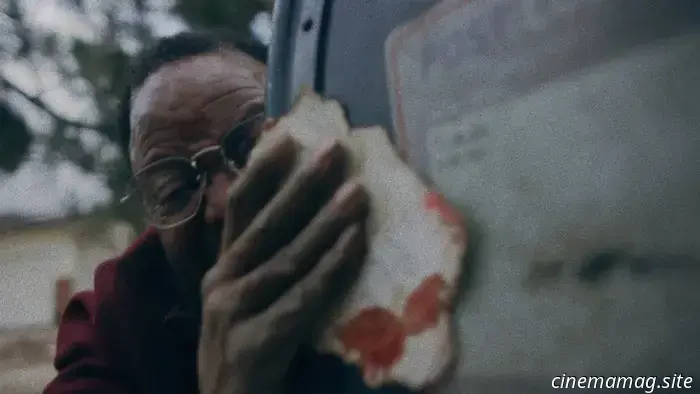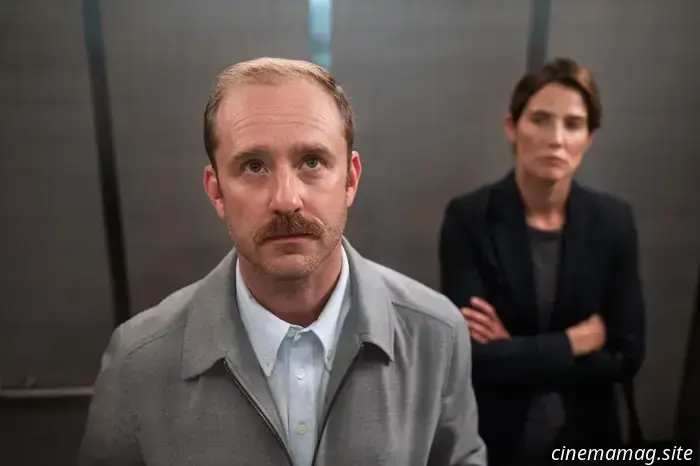
Dead Mail Review: A Fresh Take on the Slasher Genre
Note: This review was initially published as part of our 2024 SXSW coverage. Dead Mail is now available on Shudder.
Combining found footage with what seems to be grainy 16mm (the film was actually shot on an early DV), Kyle McConaghy and Joe DeBoer’s Dead Mail fully embraces the unsettling nature of its premise. Similar to Jane Schoenbrun’s I Saw the TV Glow or Kyle Edward Ball’s Skinamarink, it taps into subconscious fears, though Dead Mail leans slightly more towards the slasher genre. The film exudes an eerie vibe reminiscent of Harmony Korine’s Trash Humpers, feeling like a relic from the past. Additionally, like Schoenbrun’s work, it hints at a narrative that seems to be inspired by a 20/20 segment or a late-night documentary that a child should have avoided watching after bedtime, but did so anyway.
Dead Mail offers something unique, with its horror presented straightforwardly, undoubtedly influenced by lesser slasher films. Still, the movie is rooted in a gritty Midwestern realism that at times resembles a cold institutional study. The plot is quite straightforward: a man crawls to a neighborhood mailbox to send a letter requesting help. This letter ends up on the desk of Jasper (Tomas Boykin), a dead mail investigator at a local post office branch, regarded as the best in his field by co-workers. Outside of work, he leads a quiet life, remaining solitary and moving between his job and the boarding house where he resides, implying he’s faced hard times more than once.
He has some assistance, including talkative women Ann (Micki Jackson) and Bess (Susan Priver), as well as a computer whiz named Renée (Nick Heyman), who helps him narrow leads, analyze weather conditions that may have affected package moisture, and assist with international shipments.
McConaghy and DeBoer then introduce Trent (John Fleck), a sinister keyboard enthusiast who befriends engineer Josh (Sterling Macer Jr.), who agrees to refurbish his synthesizer. This friendship deteriorates as Trent begins to expect more, culminating in a violent sequence where he schemes to keep Josh trapped in his home. The film's atmosphere is both claustrophobic and mundane as Trent grapples with the realization of what Josh has potentially done.
The movie largely evolves into a psychological cat-and-mouse thriller that is best experienced unspoiled. It also unexpectedly serves as a tribute to civil servants—including those at the boarding house who offer support to mostly down-on-their-luck men—and pays homage to the everyday operations of the local post office. Set in the 1980s, an era when computers were relatively novel and not yet widespread, the period-accurate production design by Payton Jane and costume design by KerriAnna Savastano enhances the film’s unsettling atmosphere.
While some twists are anticipated, what distinguishes Dead Mail from typical slasher or psychological thrillers is its unique visual style and meticulous attention to detail. It is a carefully crafted film that effectively unsettles its audience. Although it may not reach the visionary heights of I Saw the TV Glow, there is a notable trend in indie cinema featuring filmmakers in their 30s and 40s revisiting narratives and cultural elements they grew up with, exploring darker outcomes. Dead Mail combines the aesthetic of a cold institutional documentary with that of a slasher film, and at its finest moments, stands out as one of the year’s most compelling horror offerings.
Dead Mail made its debut at SXSW 2024.
Other articles
 Trailer for the psychological thriller Sharp Corner featuring Ben Foster and Cobie Smulders.
Vertical has unveiled a trailer for Sharp Corner, the forthcoming thriller directed by Jason Buxton. Ben Foster plays Josh, a man whose life starts to unravel as he becomes fixated on rescuing the victims of deadly car crashes triggered by the sharp turn near his family's […]
Trailer for the psychological thriller Sharp Corner featuring Ben Foster and Cobie Smulders.
Vertical has unveiled a trailer for Sharp Corner, the forthcoming thriller directed by Jason Buxton. Ben Foster plays Josh, a man whose life starts to unravel as he becomes fixated on rescuing the victims of deadly car crashes triggered by the sharp turn near his family's […]
 Universal Monsters: The Mummy #2 - Comic Book Sneak Peek
The second issue of Image Comics and Skybound’s Universal Monsters: The Mummy will be released next week, and you can view the official preview below... A decade later, Helen Grosvenor unexpectedly encounters her past at Cairo's most famous museum. However, she is unprepared for the reality that awaits her as she faces an […]
Universal Monsters: The Mummy #2 - Comic Book Sneak Peek
The second issue of Image Comics and Skybound’s Universal Monsters: The Mummy will be released next week, and you can view the official preview below... A decade later, Helen Grosvenor unexpectedly encounters her past at Cairo's most famous museum. However, she is unprepared for the reality that awaits her as she faces an […]
 Leading Movie-Inspired Slot Games Enchanting Players in 2025 - MovieMaker Magazine
The participation in cinema and casino gaming reaches its peak in 2025. Contemporary slot games based on movies have evolved.
Leading Movie-Inspired Slot Games Enchanting Players in 2025 - MovieMaker Magazine
The participation in cinema and casino gaming reaches its peak in 2025. Contemporary slot games based on movies have evolved.
 Ryan Gosling ventures into the galaxy in Shawn Levy's Star Wars: Starfighter.
Shawn Levy is set to take on a new project in the Star Wars universe with his recently announced film, Starfighter. This was unveiled at the Star Wars Celebration 2025 event in Japan by Kathleen Kennedy, President of Lucasfilm, and Dave Filoni, Chief Creative Officer. In Levy’s Star Wars: Starfighter, featuring Ryan Gosling, audiences can expect a fresh interpretation of the franchise.
Ryan Gosling ventures into the galaxy in Shawn Levy's Star Wars: Starfighter.
Shawn Levy is set to take on a new project in the Star Wars universe with his recently announced film, Starfighter. This was unveiled at the Star Wars Celebration 2025 event in Japan by Kathleen Kennedy, President of Lucasfilm, and Dave Filoni, Chief Creative Officer. In Levy’s Star Wars: Starfighter, featuring Ryan Gosling, audiences can expect a fresh interpretation of the franchise.
 Hasbro has opened pre-orders for the G.I. Joe Classified Series, featuring Snake Eyes, Major Bludd, Monkeywrench, Cobra Commander, and Cobra C.L.A.W.
Hasbro has officially begun pre-orders for the upcoming wave of G.I. Joe Classified Series figures, featuring eagerly awaited releases including the Cobra Pilot & Cobra C.L.A.W., Snake Eyes v4, Major Bludd, Monkeywrench, and Cobra Commander with Combat Armor. You can view the official promotional images and details below or visit Hasbro Pulse for more information.
Hasbro has opened pre-orders for the G.I. Joe Classified Series, featuring Snake Eyes, Major Bludd, Monkeywrench, Cobra Commander, and Cobra C.L.A.W.
Hasbro has officially begun pre-orders for the upcoming wave of G.I. Joe Classified Series figures, featuring eagerly awaited releases including the Cobra Pilot & Cobra C.L.A.W., Snake Eyes v4, Major Bludd, Monkeywrench, and Cobra Commander with Combat Armor. You can view the official promotional images and details below or visit Hasbro Pulse for more information.
 New to Streaming: Eephus, Grand Tour, The Woman in the Yard, Youth Trilogy, and More
Every week, we spotlight significant titles that have recently become available on streaming services in the United States. Take a look at this week's picks below and explore previous compilations here. Benediction (Terence Davies) Timing plays a crucial role in a Terence Davies movie. In Benediction, his biographical film about English poet Siegfried Sassoon (portrayed by Jack Lowden), he ultimately addresses Sassoon's marriage to Hester.
New to Streaming: Eephus, Grand Tour, The Woman in the Yard, Youth Trilogy, and More
Every week, we spotlight significant titles that have recently become available on streaming services in the United States. Take a look at this week's picks below and explore previous compilations here. Benediction (Terence Davies) Timing plays a crucial role in a Terence Davies movie. In Benediction, his biographical film about English poet Siegfried Sassoon (portrayed by Jack Lowden), he ultimately addresses Sassoon's marriage to Hester.
Dead Mail Review: A Fresh Take on the Slasher Genre
Note: This review was first published as part of our coverage of SXSW 2024. Dead Mail is currently available on Shudder. Combining found footage with what looks like grainy 16mm film (in reality, they filmed it using an early DV), Kyle McConaghy and Joe DeBoer’s Dead Mail fully embraces the unsettling nature of its premise.
